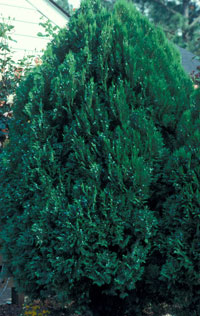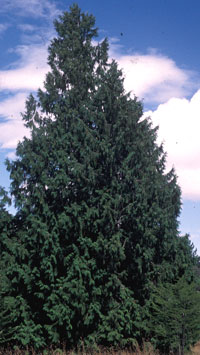The Arborvitae for the North,
American Arborvitaes (Thuja occidentalis)are very popular landscape trees and shrubs, typically narrowly pyramidal in shape, and valued for their dense foliage. Native to the United States, some reach 200 or even 300 years of age so are sometimes called the “tree of life”. Called variously Northern white cedar and American or Eastern arborvitae, these trees are among the big four evergreens found in American landscapes – the others are yews, spruce, and pine. As conifers, arborvitaes bear distinctive small cones.
 |
| Oriental Arborvitae |
The Arborvitae for the South, while not as hardy as our native American arborvitae species,
Oriental arborvitaes (Thuja orientalis) are widely planted because they tolerate heat, drought, and alkaline soil and have a reputation for toughness. For some reason this tree is often planted in cemeteries and is referred to as the Cemetery Plant.
 |
| Western Red Cedar |
In the West there is
Western Red Cedar (Thuja plicata) which is best known as the source of cedar shingles. While common in the northwest, it is a tree that deserves more attention. It is a very nice landscape tree that is not used very often east of the Rockies. Not only is it attractive, it resists deer browsing much more than do the other two arborvitaes. The wood of Western Red Cedar is used not only for shingles, but is extensively used to make shakes, siding and poles.
Size:
American arborvitaes grow to 40 to 60 feet high, and spread to 15 feet wide at maturity. The trees reach 6 feet in 7 to 8 years from a 3 year old seedling. There are several dwarf varieties such as ‘Rheingold’ that grow to only 3 or 4 feet tall.
Oriental arborvitaes may grow to 25 to 50 feet tall, and spread to 12 feet wide. However, there are several dwarf varieties offering denser branches. They are slow-growing and smaller in growth habit.
Foliage: Leaves of American arborvitae are evergreen, soft, and scale-like, rather than needled. They are arranged in flattened, horizontal sprays. Typically medium to dark-green above, lighter beneath, some varieties have gold-tipped or yellow-green foliage. In regions where winters are very cold, sometimes arborvitae foliage turns brown in late fall and remains so all winter.
The evergreen foliage of
Oriental arborvitae appears bright green above and yellow-green below, with soft, scale-like leaves arranged in more or less vertical sprays. Some shrub varieties have gold-tipped, yellow-green, or even bluish foliage. Because Oriental arborvitae are grown in milder climates, their foliage holds its color year round.
Cones:
Arborvitae “flowers” are actually tiny and inconspicuous 1/8-inch greenish cones appearing on ends of branchlets in April or May. Male and female are borne on the same plant. By early August the female cones have 8 to 12 scales and begin to weather to a more visible silvery color. They persist until February or so, unless birds and squirrels get them.
Attracting Wildlife - The dense foliage of arborvitae offer shelter to a wide variety of birds. Both birds and squirrels eat their small cones. Other visitors that are attracted to these shrubs are by their cones or are deer, moose and rabbits.
Arborvitae Plants from Amazon.com
"Emerald Green" Arborvitae ~ 30 trees ~ Most popular privacy tree.
by Arborvitae
- Mature Height: 10-14 ft & Mature Width: Depends on the spacing 2-3 ft.
- Sun: Full sun- part sun & Soil: well-drained
- Spacing: 2 ft centers (trunks 2 ft apart) You can space them wider 2.5 ft-3 ft center depending how long you want to wait for a wall.
- Hardy Zones: 2-8
- You will receive 30 tress each shipped in a 4 inch pot approx 5-6 inches tall and full.
- �Emerald Green� Mature Height: 10-14� Easy to maintain a desired height. Mature Width: Depends on the spacing 2-3�. Sun: Full sun- part sun Soil: well-drained Growth Rate: 6-9� a year once established and growing conditions. Privacy: Most popular privacy tree. Spacing: 2� centers (trunks 2� apart) You can space them wider 2.5�-3� center depending how long you want to wait for a wall. First Year: Newly-planted trees, water through-out the first spring and summer. Fragrant: Yes Hardy Zones: 2-8
Thuja Green Giant Arborvitae Plants
by Thuja plicata
- Growth rate: Rapid 3-5 feet per year once well established
- Privacy Screen-Height:40-60 feet
- Width: 12-20
- Hardiness Zone: 5-8
- Size when shipped: 9-12 inches tall (very well rooted) 2-3" pot with soil
- Growth rate: Rapid 3-5 feet per year once well established Height:40-60 feet Width: 12-20 Habit: Tightly pyramidal to conical evergreen tree; uniform appearance. Foliage: Dense, rich green Soil: Adaptable, grows in soil types from sandy loams to heavy clay. Deer - Thuja Green Giant Trees are deer-resistant trees. Therefore, these animals should not be a problem. Tree Trimming - You will not need to prune or trim your Thuja Green Giant Trees very much, if at all. It grows into a precise columnar shape if left alone. If you are looking to plant a hedge, you can trim your tree to the desired height. Privacy Screen- If you are planting a privacy barrier, plant your Thuja Green Giant Trees between 4 and 8 feet apart for a solid green barrier. They will mature to a height of between 20 and 40 feet when in a privacy screen. Plant your trees close together for a short height and far apart for a tall height. Watering - When young, make sure your tree gets water during extended dry spells, particularly in the summer months. Drooping branches are a sign of both over or under watering, so take great care of your tree. Fertilizer - These trees love fertilizer. Use only the slow-release fertilizer tablets that you have been provided with for the first growing season. Do not use stronger fertilizers until your tree becomes more established. You can use Miracle Grow, a 10-10-10 or 20-20-20 fertilizer. Fertilize twice a month when the tree is coming out of dormancy, then once a month during the summer. Stop fertilizing before the tree goes back into dormancy. Quantity Available Hardiness Zone: 5-8 Not recommitted in full sun in zone 9
'Nigra Dark Green' Arborvitae Shrub - Thuja - Evergreen
by Hirts: Trees & Shrubs
- Thuja occidentalis 'Nigra Dark Green'
- Hardy Zones 3-7, Full Sun to Part Shade
- Mature Height: 20-30'
- American Beauties Native Plant
- Immediate shipping, Size Shipped: 4" pot
- Considered one of the best! A pyramidal form with deep green foliage and good winter color.
'North Pole' Wintergreen Arborvitae - Thuja - Evergreen
by Hirts: Trees & Shrubs
- Thuja occidentalis 'North Pole'
- Hardy Zones 3-7, Full Sun to Part Shade
- Mature Height: 10-15'
- Prefers sun
- Size Shipped: 4" pot, Immediate shipping
- A narrow columnar selection of 'Wintergreen' with excellent hardiness and dark green winter foliage color. More narrow than 'Smaragd' (aka Emerald Green). Resistant to winter burn.





